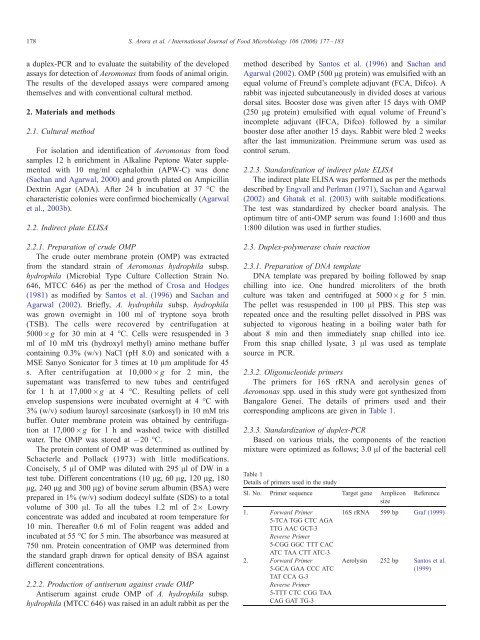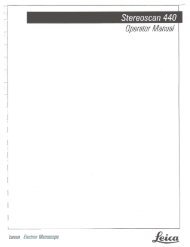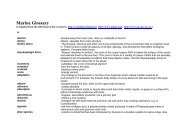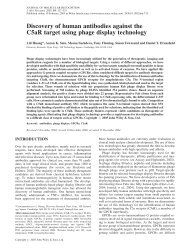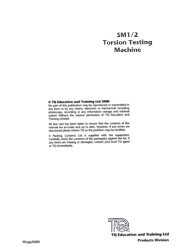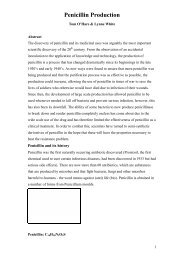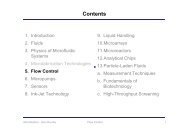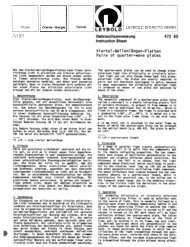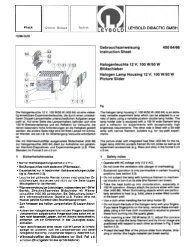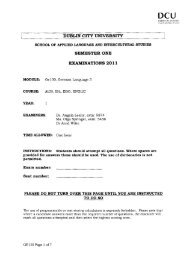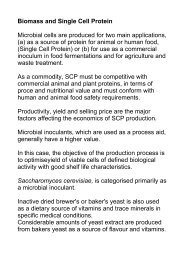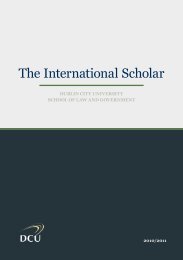Comparison of ELISA and PCR vis-a`-vis cultural methods for ...
Comparison of ELISA and PCR vis-a`-vis cultural methods for ...
Comparison of ELISA and PCR vis-a`-vis cultural methods for ...
You also want an ePaper? Increase the reach of your titles
YUMPU automatically turns print PDFs into web optimized ePapers that Google loves.
178<br />
a duplex-<strong>PCR</strong> <strong>and</strong> to evaluate the suitability <strong>of</strong> the developed<br />
assays <strong>for</strong> detection <strong>of</strong> Aeromonas from foods <strong>of</strong> animal origin.<br />
The results <strong>of</strong> the developed assays were compared among<br />
themselves <strong>and</strong> with conventional <strong>cultural</strong> method.<br />
2. Materials <strong>and</strong> <strong>methods</strong><br />
2.1. Cultural method<br />
For isolation <strong>and</strong> identification <strong>of</strong> Aeromonas from food<br />
samples 12 h enrichment in Alkaline Peptone Water supplemented<br />
with 10 mg/ml cephalothin (APW-C) was done<br />
(Sachan <strong>and</strong> Agarwal, 2000) <strong>and</strong> growth plated on Ampicillin<br />
Dextrin Agar (ADA). After 24 h incubation at 37 -C the<br />
characteristic colonies were confirmed biochemically (Agarwal<br />
et al., 2003b).<br />
2.2. Indirect plate <strong>ELISA</strong><br />
2.2.1. Preparation <strong>of</strong> crude OMP<br />
The crude outer membrane protein (OMP) was extracted<br />
from the st<strong>and</strong>ard strain <strong>of</strong> Aeromonas hydrophila subsp.<br />
hydrophila (Microbial Type Culture Collection Strain No.<br />
646, MTCC 646) as per the method <strong>of</strong> Crosa <strong>and</strong> Hodges<br />
(1981) as modified by Santos et al. (1996) <strong>and</strong> Sachan <strong>and</strong><br />
Agarwal (2002). Briefly, A. hydrophila subsp. hydrophila<br />
was grown overnight in 100 ml <strong>of</strong> tryptone soya broth<br />
(TSB). The cells were recovered by centrifugation at<br />
5000 g <strong>for</strong> 30 min at 4 -C. Cells were resuspended in 3<br />
ml <strong>of</strong> 10 mM tris (hydroxyl methyl) amino methane buffer<br />
containing 0.3% (w/v) NaCl (pH 8.0) <strong>and</strong> sonicated with a<br />
MSE Sanyo Sonicator <strong>for</strong> 3 times at 10 Am amplitude <strong>for</strong> 45<br />
s. After centrifugation at 10,000 g <strong>for</strong> 2 min, the<br />
supernatant was transferred to new tubes <strong>and</strong> centrifuged<br />
<strong>for</strong> 1 h at 17,000 g at 4 -C. Resulting pellets <strong>of</strong> cell<br />
envelop suspensions were incubated overnight at 4 -C with<br />
3% (w/v) sodium lauroyl sarcosinate (sarkosyl) in 10 mM tris<br />
buffer. Outer membrane protein was obtained by centrifugation<br />
at 17,000 g <strong>for</strong> 1 h <strong>and</strong> washed twice with distilled<br />
water. The OMP was stored at 20 -C.<br />
The protein content <strong>of</strong> OMP was determined as outlined by<br />
Schacterle <strong>and</strong> Pollack (1973) with little modifications.<br />
Concisely, 5 Al <strong>of</strong> OMP was diluted with 295 Al <strong>of</strong>DWina<br />
test tube. Different concentrations (10 Ag, 60 Ag, 120 Ag, 180<br />
Ag, 240 Ag <strong>and</strong> 300 Ag) <strong>of</strong> bovine serum albumin (BSA) were<br />
prepared in 1% (w/v) sodium dodecyl sulfate (SDS) to a total<br />
volume <strong>of</strong> 300 Al. To all the tubes 1.2 ml <strong>of</strong> 2 Lowry<br />
concentrate was added <strong>and</strong> incubated at room temperature <strong>for</strong><br />
10 min. Thereafter 0.6 ml <strong>of</strong> Folin reagent was added <strong>and</strong><br />
incubated at 55 -C <strong>for</strong> 5 min. The absorbance was measured at<br />
750 nm. Protein concentration <strong>of</strong> OMP was determined from<br />
the st<strong>and</strong>ard graph drawn <strong>for</strong> optical density <strong>of</strong> BSA against<br />
different concentrations.<br />
2.2.2. Production <strong>of</strong> antiserum against crude OMP<br />
Antiserum against crude OMP <strong>of</strong> A. hydrophila subsp.<br />
hydrophila (MTCC 646) was raised in an adult rabbit as per the<br />
S. Arora et al. / International Journal <strong>of</strong> Food Microbiology 106 (2006) 177–183<br />
method described by Santos et al. (1996) <strong>and</strong> Sachan <strong>and</strong><br />
Agarwal (2002). OMP (500 Ag protein) was emulsified with an<br />
equal volume <strong>of</strong> Freund’s complete adjuvant (FCA, Difco). A<br />
rabbit was injected subcutaneously in divided doses at various<br />
dorsal sites. Booster dose was given after 15 days with OMP<br />
(250 Ag protein) emulsified with equal volume <strong>of</strong> Freund’s<br />
incomplete adjuvant (IFCA, Difco) followed by a similar<br />
booster dose after another 15 days. Rabbit were bled 2 weeks<br />
after the last immunization. Preimmune serum was used as<br />
control serum.<br />
2.2.3. St<strong>and</strong>ardization <strong>of</strong> indirect plate <strong>ELISA</strong><br />
The indirect plate <strong>ELISA</strong> was per<strong>for</strong>med as per the <strong>methods</strong><br />
described by Engvall <strong>and</strong> Perlman (1971), Sachan <strong>and</strong> Agarwal<br />
(2002) <strong>and</strong> Ghatak et al. (2003) with suitable modifications.<br />
The test was st<strong>and</strong>ardized by checker board analysis. The<br />
optimum titre <strong>of</strong> anti-OMP serum was found 1:1600 <strong>and</strong> thus<br />
1:800 dilution was used in further studies.<br />
2.3. Duplex-polymerase chain reaction<br />
2.3.1. Preparation <strong>of</strong> DNA template<br />
DNA template was prepared by boiling followed by snap<br />
chilling into ice. One hundred microliters <strong>of</strong> the broth<br />
culture was taken <strong>and</strong> centrifuged at 5000 g <strong>for</strong> 5 min.<br />
The pellet was resuspended in 100 Al PBS. This step was<br />
repeated once <strong>and</strong> the resulting pellet dissolved in PBS was<br />
subjected to vigorous heating in a boiling water bath <strong>for</strong><br />
about 8 min <strong>and</strong> then immediately snap chilled into ice.<br />
From this snap chilled lysate, 3 Al was used as template<br />
source in <strong>PCR</strong>.<br />
2.3.2. Oligonucleotide primers<br />
The primers <strong>for</strong> 16S rRNA <strong>and</strong> aerolysin genes <strong>of</strong><br />
Aeromonas spp. used in this study were got synthesized from<br />
Bangalore Genei. The details <strong>of</strong> primers used <strong>and</strong> their<br />
corresponding amplicons are given in Table 1.<br />
2.3.3. St<strong>and</strong>ardization <strong>of</strong> duplex-<strong>PCR</strong><br />
Based on various trials, the components <strong>of</strong> the reaction<br />
mixture were optimized as follows; 3.0 Al <strong>of</strong> the bacterial cell<br />
Table 1<br />
Details <strong>of</strong> primers used in the study<br />
Sl. No. Primer sequence Target gene Amplicon<br />
size<br />
Reference<br />
1. Forward Primer<br />
5-TCA TGG CTC AGA<br />
TTG AAC GCT-3<br />
Reverse Primer<br />
5-CGG GGC TTT CAC<br />
ATC TAA CTT ATC-3<br />
16S rRNA 599 bp Graf (1999)<br />
2. Forward Primer Aerolysin 252 bp Santos et al.<br />
5-GCA GAA CCC ATC<br />
TAT CCA G-3<br />
Reverse Primer<br />
5-TTT CTC CGG TAA<br />
CAG GAT TG-3<br />
(1999)


